Today, I was thrilled to read an e-mail from a reader who was contemplating taking a DNA test. I always love to hear from you guys, and of course, I love to talk about DNA testing.
When I was responding to the e-mail, I started thinking about all of the amazing things that I have learned from my own Ancestry DNA test, and I thought I would put this post together for you. I hope that you get some inspiration and curiosity about your own unique heritage from reading this post, which I call the "Ten Things I Learned From My Ancestry DNA Test".
I'm 43% Eastern European
Growing up, I always knew that my mom's paternal grandfather had Slovak parents, though they were called Czechoslovakian when I was a kid. In addition, I knew that her maternal grandfather was the child of Polish immigrants. So when I got my DNA test results back, I was expecting to see at least some Polish and Slovak DNA.
Boy was I surprised! The first thing that surprised me was that the testing companies can't really isolate a specific "Polish" or "Slovak" region on these autosomal DNA tests, yet.
I hope they can in the future, but for now, I have to accept a more general "Eastern European" ethnicity on my results. I was also surprised to learn that I was 43% Eastern European, which was much higher than I would have expected with only two great-grandparents having Eastern European heritage.
Take a look at the image below to see how my Eastern European appeared on my results. It was my highest percentage!
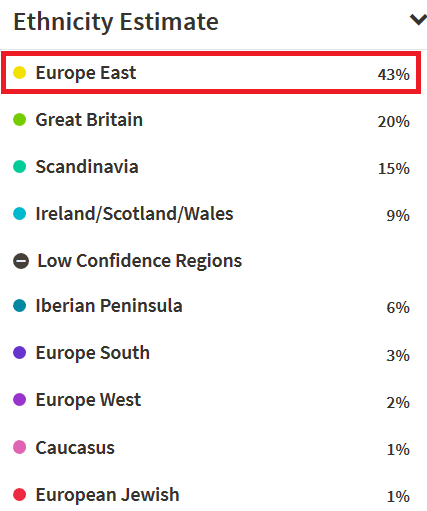
As it turns out, I inherited Eastern European from both sides of my family. I thought my dad was only English and Dutch, but I learned that my dad had a German grandmother.
On my mom's side there was German, too, and many Germans have Eastern European DNA. This is why I have such a high Eastern European percentage, which I found very interesting.
I share more DNA with my grandmother than I share with my aunt
When I got my DNA results back and checked my match list, I realized that my DNA matches were listed in the order of closest to most distant. Ancestry knows exactly how much DNA you share with your matches and organizes them into categories.
Aunts, uncles, and grandparents are considered close family, so they show up in that category. Ancestry doesn't know exactly how someone is related to me, but there are ranges of shared DNA that are common between most relationships.
Using this information, Ancestry can place my matches into categories to make it easier for me. While I have to figure out the exact relationship on my own, using more traditional methods, I do appreciate the clues that Ancestry provides.
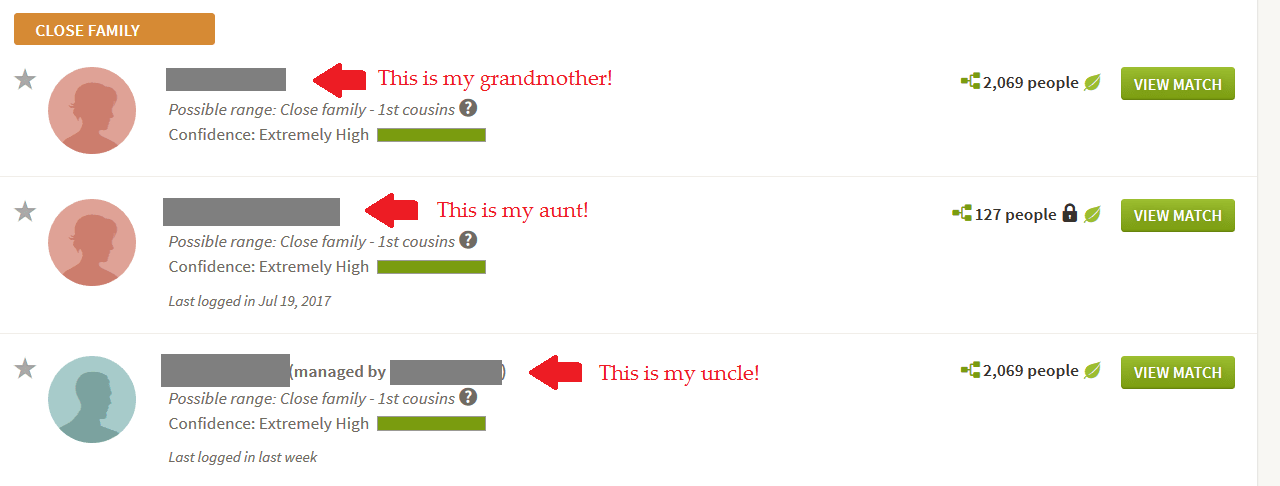
My great-uncle had a child he never knew about
When I first did my DNA test, there was a 1st-2nd cousin match that was a mystery to me. It took me a few years to figure it out, but it turns out that my great-uncle had had a child with his girlfriend when he was young, and he never knew about it.
Both of them were interested in having a relationship with each other, which I am very happy about, and I felt very happy knowing that I played a part in connecting my cousin with their biological father.
The cousin was a first cousin once-removed to me, and a first cousin to one of my parents. We now have a budding friendship/cousin-ship, and it has been a blessing for both of us.
I have Jewish ancestry
When I got my DNA results back, I was surprised to find that I had 1% Jewish ancestry. While many people tend to dismiss very small percentages (like the 1% European Jewish) in their results, I was intrigued.
My sister did a test and got 2%, and my father did a test and had 2% as well. With a very large percentage of Eastern European ancestry, with verified roots in Germany, Poland, and Slovakia, it's really not a crazy idea that my family has distant Ashkenazi Jewish ancestors.
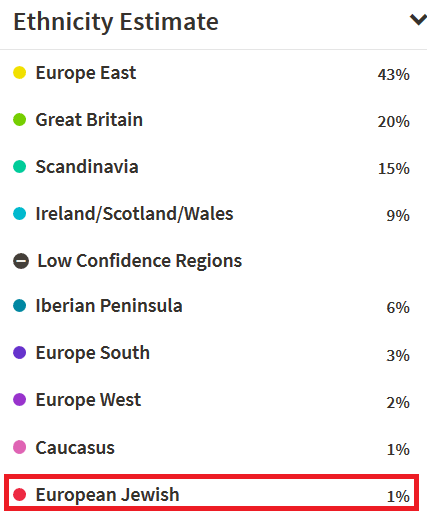
Just out of curiosity, I downloaded my DNA from Ancestry DNA and uploaded it for free to My Heritage DNA. They test for more Jewish regions than the other companies do, and I got 6% Ashkenazi Jew on the ethnicity report that they provided me with.
The following is a screenshot of my Ashkenazi results with My Heritage. There is a ton you can do with your raw DNA file on other sites - it's so much fun!

I still haven't found my German ancestors who gave me my Ashkenazi DNA, but I'm still looking. I've completed my research in Slovakia and Poland... maybe this year will be the year of Germany in my family tree.
DNA testing helped me prove the identity of my great-grandmother's parents
One of the reasons that I first became interested in DNA testing is because I realized I didn't know the names of all of my great-grandparents, or the names and countries of birth of all of my great-great grandparents. I was surprised to learn, during my preliminary research before my DNA test results came back, that one of my mom's grandmother's was born in New Jersey.
No one in my family knew anything about her ancestry. They didn't even know for sure how old she was or where she was born - I was able to find this out from old census records.
Using these census records, and other documents available online from Ancestry, I was able to put together a basic family tree for my great-grandmother, including about three generations back on most of her lines. When I got my DNA results back, I saw almost immediately that my research was correct.
I have dozens of cousins on that side of the family who have done DNA tests, and they all descend from the same couple that turns out to be the grandparents of my great-grandmother. I had so many cousins on that line that I was actually places into a DNA Circle - in other words, my research was "proven".
One of my grandmother's brothers was her half-brother
There was this family rumor that one of my grandmother's little brothers was not a full sibling, but a half sibling. One thing that I have learned through this DNA testing is that what people "think" they know about the family history is not always correct, so I was very skeptical and didn't want to believe this rumor.
Since my grandmother's little brother was born in the 1930's, I was sure that no one could have known for sure that he wasn't the biological child of my great-grandfather.
One other bit of information about this great uncle of mine, who was supposedly a half-great uncle, was that he never had any children. He died when he was in his 20's, so it was theoretically possible for that to be true.
As the relatively new saying goes, DNA doesn't lie. Since I thought that my great-uncle had not had any children, I was convinced that we would never know the truth about his parentage.
A few months ago, a new cousin popped up for me. Sure enough, this cousin matched my parent at the exact half-first cousin level, and shows my great-uncle as her father.
My great-grandmother's genealogy research was right
My great-grandmother, and my great-great grandmother, and even my great-great-great-grandmother on my dad's side of the family were seasoned genealogists. They traveled all around the country, and even the world, searching for original documents and were very proud of their pedigree and their research.
My great-great-great grandmother's work traced her lines all the way back to the Mayflower, which was already a very well-known fact in her family.
The pride and confidence was always a little annoying to me as a kid, since I always felt like my grandmother looked down on my mother's side of the family for being primarily of Eastern European descent. A tiny little part of me (the youthful, overconfident, and maybe a little spiteful part) was hoping to find DNA evidence that my grandmother's family was not who they thought they were.
I was secretly hoping to find proof that the Mayflower connection was bogus.
When I made my family tree on Ancestry, I basically used all of the paper documentation that my genealogist ancestors had compiled in order to do it quickly and not reinvent the wheel, but I was expecting to have to make some corrections or changes once I got my results.
When I attached my DNA results to my family tree, I got dozens of Shared Ancestor Hints within a few days, and some went back as far as my 9th great-grandfather on those well-documented lines (that I wanted to disprove).
This wasn't good enough for me, naturally, so I had my grandmother do a test. She has dozens of DNA matches that have the grandchildren of our Mayflower ancestors as common ancestors, through the Shared Ancestor Hint tool.
I've done analysis on her DNA results through several other sites and have found no evidence whatsoever that anything that my female ancestors did in their family tree research was outright incorrect.
So instead of being able to tell my family, smugly, that my modern fancy-pants DNA research has been able to prove that my great-great-great grandmother's research was wrong, I now feel obligated to say a little prayer of apology, and more importantly, thank her for working so hard to leave all of this research to her descendants.
Thanks, Grandma Manchester, I am sorry for being an ungrateful brat!
A DNA test can't tell me for sure whether I have distant Native American ancestors
I've written a little bit about this here on the site, but it worth mentioning here as it definitely counts as something that I learned through my DNA results. When I first tested, I naturally assumed that any and all of my ancestry would be visible on my results.
Boy, was I wrong! As it turns out, you only really see a portion of your ancestry from the past 300-500 years. It's nothing that the testing companies are doing wrong - it's just science.
As it turns out, we inherit 50% of each of our parents' DNA, but the ethnicity doesn't get passed down "in half" as it might be easy to assume. And even if it did, after several generations it would be too small to even show up on the test. In reality, the way ethnicity is inherited is much more complicated and random.
The smaller a percentage of a particular ethnicity that our parents have, the less likely it is that we will inherit any of it, and it can actually disappear completely in descendants after only 5 generations.
Even more mind blowing is the fact that the more distant our ancestor, the less likely it is that we share any DNA with them at all. This leads me to one of the other reasons that I wanted to take a DNA test.
My grandmother has beautiful, long, black hair, olive skin, and dark eyes, and our whole family had always wondered if we had Native American ancestry that we didn't know about. As it turns out, my grandmother's complexion and beautiful hair can likely be attributed to her Iberian and Southern European roots (which we didn't know about prior to her testing!).
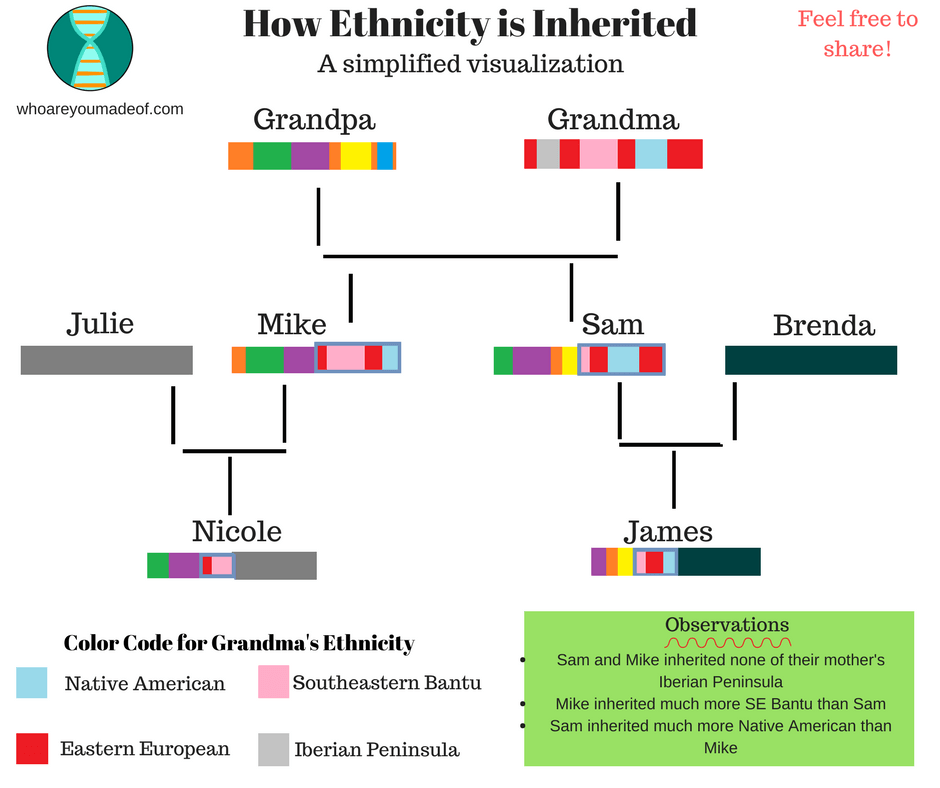
Just because my grandmother didn't show any Native American DNA doesn't mean she has absolutely no Native American ancestors. It's possible, and maybe even likely, that she had at least one very distant ancestor somewhere along the line, especially since some of her ancestors were living in North America four hundred years ago.
That's 16 generations and an awful lot of ancestors (you can have about 65,536 great-grandparents!)
I'm 6% Iberian Peninsula
I mentioned above that my grandmother had a substantial amount of Iberian Peninsula DNA - 15%. She passed it down to my dad, who in turn passed it down to me. This was a complete surprise to me, as it is to many people.
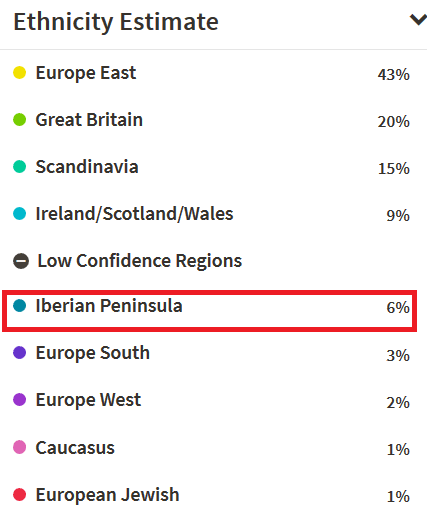
I love genealogy
When I was a kid, genealogy seemed like it was for retired people who had nothing better to do than search through old records and documents. It seemed boring, even though I did have a moderate interest in talking to my grandparents about their history.
Boy, was I wrong! Genealogy is for anyone who is interested in their family's ancestry, and the addition of a DNA test makes it all the more fascinating. I first took my DNA test out of curiosity, and it turned into this incredibly fulfilling hobby.
While I can't wait until I am retired so that way I have more time to dedicate to my research, I would encourage you not to wait until you are retired to get started. Talk to your family members while you can, take notes, and learn as much as you can about your recent ancestors.
If people say that they have photographs or old documents, ask if you can make copies. Even if you are not ready to start making a family tree, holding on to these records is a great gift to the future generations. Plus, you never know when you might catch the family research bug!
Do you want to test your DNA?
Are you interested in testing your DNA? I took my test a few years ago, and it has been exceptionally interesting a ton of fun. I generally recommend testing with Ancestry DNA, since you can build a tree on the same site, connect your DNA to your family tree and access additional features.
If you would like to go ahead and get started with your test, you can use the following link (I will get a very small commission at no extra cost to you, and it helps so much to support this website, so thanks!): Discovery the story AncestryDNA® can tell
Conclusion
I hope that this post was interesting to you, and that it helped you realize what you might learn if you decide to do an Ancestry DNA test. If you have any questions about anything that I mentioned in this post, or would like to share your own experience about something that you learned from DNA testing, I am looking forward to hearing from you in the comments.
Thanks for stopping by!

